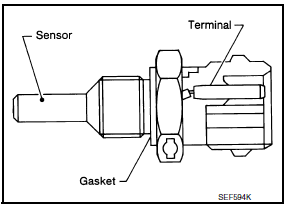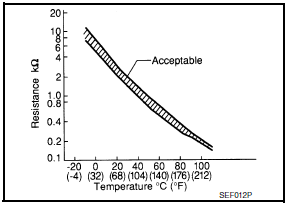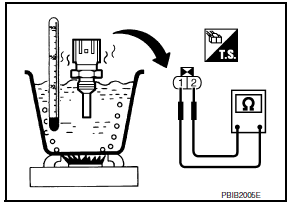Nissan Maxima Service and Repair Manual: P0125 ECT sensor
Description

The engine coolant temperature sensor is used to detect the engine coolant temperature. The sensor modifies a voltage signal from the ECM. The modified signal returns to the ECM as the engine coolant temperature input. The sensor uses a thermistor which is sensitive to the change in temperature. The electrical resistance of the thermistor decreases as temperature increases.
<Reference data>


*: These data are reference values and are measured between ECM terminals 46 (Engine coolant temperature sensor) and 52 (Sensor ground).
DTC Logic
DTC DETECTION LOGIC
NOTE:
- If DTC P0125 is displayed with P0116, first perform the trouble diagnosis for DTC P0116. Refer to EC- 201, "DTC Logic".
- If DTC P0125 is displayed with P0117 or P0118, first perform the trouble diagnosis for DTC P0117, P0118. Refer to EC-204, "DTC Logic".

DTC CONFIRMATION PROCEDURE
1.PRECONDITIONING
If DTC Confirmation Procedure has been previously conducted, always perform the following before conducting the next test.
- Turn ignition switch OFF and wait at least 10 seconds.
- Turn ignition switch ON.
- Turn ignition switch OFF and wait at least 10 seconds.
2.CHECK ENGINE COOLANT TEMPERATURE SENSOR FUNCTION
With CONSULT
- Turn ignition switch ON.
- Select "DATA MONITOR" mode with CONSULT.
- Check that "COOLAN TEMP/S" is above 10C (50F).
With GST
Follow the procedure "With CONSULT" above.
3.PERFORM DTC CONFIRMATION PROCEDURE
With CONSULT
- Start engine and run it for 65 minutes at idle speed.
If "COOLAN TEMP/S" increases to more than 10C (50F) within 65 minutes, stop engine because the test result will be OK. CAUTION: Never overheat engine.
- Check 1st trip DTC.
With GST
Follow the procedure "With CONSULT" above.
Diagnosis Procedure
1.CHECK GROUND CONNECTION
- Turn ignition switch OFF.
- Check ground connection E9.
2.CHECK ENGINE COOLANT TEMPERATURE SENSOR
3.CHECK THERMOSTAT OPERATION
When the engine is cold [lower than 70C (158F)] condition, grasp lower radiator hose and confirm that the engine coolant does not flow.
4.CHECK INTERMITTENT INCIDENT
Component Inspection
1.CHECK ENGINE COOLANT TEMPERATURE SENSOR

- Turn ignition switch OFF.
- Disconnect engine coolant temperature sensor harness connector.
- Remove engine coolant temperature sensor
- Check resistance between engine coolant temperature sensor terminals as per the following.

 P0122, P0123 TP sensor
P0122, P0123 TP sensor
Description
Electric throttle control actuator consists of throttle control motor,
throttle position sensor, etc. The throttle position sensor responds to
the throttle valve movement.
The ...
 P0127 IAT sensor
P0127 IAT sensor
Description
The intake air temperature sensor is built-into the mass air flow sensor
(1). The sensor detects intake air temperature and transmits a
signal to the ECM.
The temperature sensi ...
Other materials:
Daytime running light system
System Diagram
System Description
The headlamp system for Canada vehicles is equipped with a daytime light
relay that activates the high beam headlamps at approximately half
illumination whenever the engine is running. If the parking brake is
depressed before the engine is started, the day ...
Basic inspection
DIAGNOSIS AND REPAIR WORKFLOW
Work Flow (With EXP-800 NI or GR8-1200 NI)
CHARGING SYSTEM DIAGNOSIS WITH EXP-800 NI OR GR8-1200 NI
To test the charging system, use the following special service tools:
EXP-800 NI Battery and electrical diagnostic analyzer
GR8-1200 NI Multitasking battery and ...
Symptom diagnosis
SQUEAK AND RATTLE TROUBLE DIAGNOSES
Work Flow
CUSTOMER INTERVIEW
Interview the customer if possible, to determine the conditions that exist
when the noise occurs. Use the Diagnostic Worksheet during the interview to
document the facts and conditions when the noise occurs and any customer' ...
Nissan Maxima Owners Manual
- Illustrated table of contents
- Safety-Seats, seat belts and supplemental restraint system
- Instruments and controls
- Pre-driving checks and adjustments
- Monitor, climate, audio, phone and voice recognition systems
- Starting and driving
- In case of emergency
- Appearance and care
- Do-it-yourself
- Maintenance and schedules
- Technical and consumer information
Nissan Maxima Service and Repair Manual
0.0053
